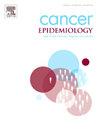Prevalence of Human Papilloma Virus in Coquimbo, Chile
IF 2.4
3区 医学
Q3 ONCOLOGY
引用次数: 0
Abstract
Background
Human papillomavirus (HPV) is the main pathogen responsible of cervical cancer. The characterization of HPV genotypes in preneoplastic lesions and cervical cancer could establishes the effectiveness of the vaccination plan in the Chilean population. The aim of this study was to determine the frequency of HPV in women in the Coquimbo region.
Methods
A total of 1235 cervical samples from women aged 20–64 years old who attended gynecological check-ups from April 2023 to July 2024 were analyzed to detect HPV genotypes using qPCR.
Results
The overall prevalence rate of HPV infection was 26.56 %, while the prevalence of HR-HPV in age groups G1 (20–29 years) and G2 (30–64 years) was 47.69 % and 24.07 %, respectively. The most prevalent genotypes of HPV infection among our entire population were HPV16, HPV51 and HPV 31. Single infection (74.70 %) was the main pattern of HPV infection observed in the entire group, followed by double infection (16.46 %) and multiple infection (8.84 %), which was similar in Group 2, with percentiles of 76.07 %, 15.79 % and 7.14 %, respectively. However, in Group 1 a higher frequency of multiple HPV infections was observed, with 16.13 %.
Conclusion
This HPV prevalence infections among women in the Coquimbo region appears to be higher than the reported in Chile. In the rest of country, HPV prevalence is likely underestimated. Molecular detection of 14 HR-HPV genotypes is important because it will not only help women avoid cervical cancer but could also inform the introduction of new vaccines targeting a broader spectrum of HR-HPV.
智利科金博市人乳头瘤病毒流行情况
背景:人乳头瘤病毒(HPV)是宫颈癌的主要病原体。瘤前病变和宫颈癌中HPV基因型的特征可以确定疫苗接种计划在智利人口中的有效性。本研究的目的是确定科金博地区妇女中HPV的频率。方法对2023年4月至2024年7月接受妇科检查的20 ~ 64岁女性1235份宫颈样本进行qPCR检测HPV基因型。结果总HPV感染率为26.56 %,G1组(20 ~ 29岁)和G2组(30 ~ 64岁)HR-HPV感染率分别为47.69 %和24.07 %。我们整个人群中最流行的HPV感染基因型是HPV16、HPV51和hpv31。全组HPV感染以单次感染为主(74.70 %),其次为双次感染(16.46 %)和多次感染(8.84 %),两组差异无统计学意义,百分位数分别为76.07 %、15.79 %和7.14 %。然而,在第1组中,观察到多发HPV感染的频率较高,为16.13 %。结论科金博地区妇女的HPV感染率似乎高于智利报告的感染率。在该国其他地区,HPV患病率可能被低估了。14种HR-HPV基因型的分子检测很重要,因为它不仅可以帮助妇女避免宫颈癌,而且还可以为引入针对更广泛的HR-HPV的新疫苗提供信息。
本文章由计算机程序翻译,如有差异,请以英文原文为准。
求助全文
约1分钟内获得全文
求助全文
来源期刊

Cancer Epidemiology
医学-肿瘤学
CiteScore
4.50
自引率
3.80%
发文量
200
审稿时长
39 days
期刊介绍:
Cancer Epidemiology is dedicated to increasing understanding about cancer causes, prevention and control. The scope of the journal embraces all aspects of cancer epidemiology including:
• Descriptive epidemiology
• Studies of risk factors for disease initiation, development and prognosis
• Screening and early detection
• Prevention and control
• Methodological issues
The journal publishes original research articles (full length and short reports), systematic reviews and meta-analyses, editorials, commentaries and letters to the editor commenting on previously published research.
 求助内容:
求助内容: 应助结果提醒方式:
应助结果提醒方式:


